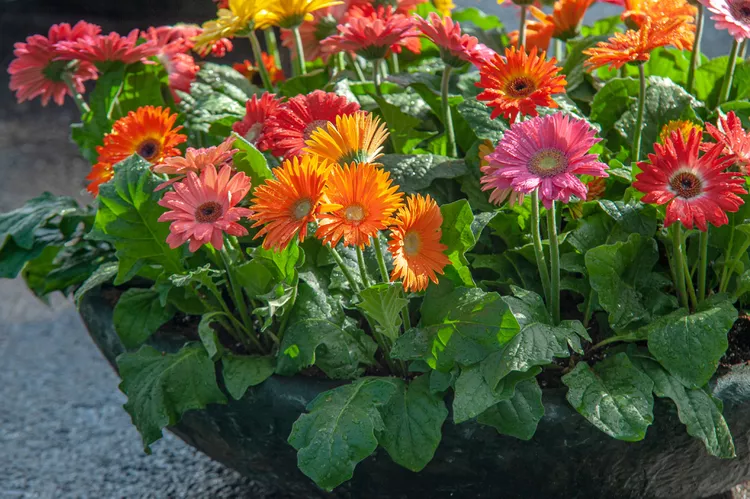Title: Gerbera Flowers: A Vibrant Touch to Your Garden and Home
Introduction
How to Care for Gerbera Flowers
Bright, cheerful, and full of life—gerbera daisies (genus Gerbera) are one of the most popular and beloved flowers in gardens and floral arrangements. With their stunning, bold colors and large, daisy-like blooms, gerberas bring an instant splash of vibrancy to any space. Whether you’re looking to add a pop of color to your garden, create an indoor floral display, or give a thoughtful bouquet, gerbera flowers are the perfect choice. In this blog, we’ll dive into everything you need to know about these beautiful blooms—from their types and planting tips to their care and uses.
1. What Are Gerbera Flowers?
Gerbera flowers are part of the Asteraceae family, which also includes sunflowers, daisies, and chrysanthemums. Known for their striking appearance, gerberas come in a variety of colors, including red, pink, orange, yellow, white, and even purple. Their large, showy blooms have a unique shape, with a central disc surrounded by vibrant petals that can range from simple to ruffled. Native to South Africa, Gerberas thrive in sunny, warm environments but can also be grown in cooler regions with the right care.
2. Types of Gerbera Flowers
Gerbera daisies come in a wide range of varieties, each offering a unique appearance and color palette. Some of the most popular types include:
- Gerbera Jamesonii:
This is the most common type of gerbera, characterized by its bright, bold blooms. They are often found in shades of red, orange, yellow, and pink. - Mini Gerberas:
These are smaller versions of the traditional gerbera, with smaller blooms and a more compact growing habit. Mini gerberas are often used in small arrangements or as indoor plants. - Cactus-Type Gerberas:
These have longer, narrower petals that give the flower a more spiky, “cactus-like” appearance. They tend to have a more unique, exotic look. - Spider-Type Gerberas:
With their long, slender petals, spider-type gerberas look somewhat like a spider’s legs, giving them a distinct, elegant appearance. - Hybrid Gerberas:
These are specially bred to have larger blooms, often with multiple color layers or unusual petal shapes, making them a favorite for cutting gardens and floral arrangements.
3. Planting Gerbera Flowers: Tips for Success
Planting gerbera daisies is relatively straightforward, but they do require a few key conditions to thrive:
- Choose the Right Location:
Gerberas need plenty of sunlight—ideally around 6 hours of direct sunlight each day. They will struggle in shaded areas and are not frost-tolerant, so plant them in a warm, sunny spot in your garden. If you live in a cooler climate, consider planting them in pots so you can bring them indoors when the weather turns chilly. - Soil Requirements:
Gerberas prefer well-drained, fertile soil. Use a soil mix that retains moisture but doesn’t stay soggy. Adding organic matter, such as compost or peat moss, can improve soil texture and drainage. - Planting Depth:
Plant gerbera daisies in holes that are slightly deeper than their root balls. Make sure the crown (the part where the stem meets the roots) is level with the soil surface to avoid rot.
4. Caring for Gerbera Flowers
Gerberas are fairly easy to care for once they are planted, but like all flowers, they do require attention to thrive. Here are some essential care tips:
- Watering:
Gerbera daisies like their soil to be consistently moist, but they don’t tolerate sitting in water. Water your plants regularly, but allow the soil to dry out slightly between waterings. Avoid getting water on the leaves or flowers, as this can encourage mold and mildew. - Fertilizing:
Gerberas are heavy feeders and benefit from regular fertilization. Use a balanced liquid fertilizer every two weeks during the growing season (spring and summer) to encourage healthy growth and vibrant blooms. Reduce fertilization in the fall and winter when the plant enters its dormant phase. - Deadheading:
To keep your gerbera plants looking tidy and encourage more blooms, remove spent flowers by cutting them off at the base of the stem. This is called “deadheading,” and it helps the plant focus its energy on producing new flowers. - Pruning:
Gerberas generally don’t require heavy pruning. However, you should trim away any dead or damaged leaves to maintain a healthy appearance. If the plant becomes leggy or overgrown, you can also trim back the stems to encourage new growth. - Temperature and Humidity:
Gerberas prefer temperatures between 60–75°F (15–24°C) during the day and slightly cooler temperatures at night. They also thrive in moderate humidity. In particularly dry areas, you may need to increase humidity around the plant by misting or using a humidifier.
5. Common Problems and How to Fix Them
While gerbera daisies are generally low-maintenance, they can be prone to a few common issues:
- Root Rot:
If gerberas are overwatered or planted in poorly draining soil, they can develop root rot. Make sure the soil drains well and avoid watering the plant too frequently. - Powdery Mildew:
Powdery mildew can affect gerberas, especially in humid conditions. To prevent it, ensure good air circulation around the plant, avoid overhead watering, and remove infected leaves immediately. A mild fungicide can also help. - Aphids and Insects:
Gerberas can sometimes attract aphids, mealybugs, and other pests. If you spot any, wash them off with a gentle stream of water or use insecticidal soap.
6. Gerbera Flowers in Garden Design
Gerbera daisies are versatile and can be used in many creative ways to enhance your garden or home:
- Borders and Edges:
Plant gerberas along the edges of your garden beds for a colorful border. Their bright blooms will add an instant focal point and create a cheerful atmosphere. - Container Gardens:
Gerberas do exceptionally well in pots, making them perfect for balconies, patios, or even as indoor plants. Choose a container with good drainage to prevent waterlogging. - Cut Flowers and Floral Arrangements:
Gerberas are a staple in floral arrangements due to their bold colors and long-lasting blooms. Whether you’re creating a bouquet for a special occasion or just a simple vase arrangement, gerberas add a cheerful touch to any room. - Mixing with Other Plants:
Gerberas pair beautifully with other bright, sun-loving flowers like marigolds, petunias, and zinnias. They also work well in mixed containers with plants of varying heights and textures.
7. Fun Facts About Gerbera Flowers
- Symbolism:
Gerbera daisies symbolize purity, beauty, and cheerfulness. They’re often given as gifts to convey well-wishes, happiness, and admiration. - History:
Gerberas are named after the German botanist Traugott Gerber, who introduced them to Europe in the 18th century. They’ve since become one of the world’s most popular flowers, known for their striking appearance and vibrant colors.
Conclusion: Why Gerbera Flowers Are a Must-Have for Your Garden
Gerbera daisies are not only beautiful but also incredibly versatile and easy to grow. Whether you plant them in your garden or use them in cut flower arrangements, they’ll always bring a splash of color and joy. With their range of colors and forms, gerberas can fit any gardening style—from modern and minimalistic to whimsical and colorful.
Call to Action:
Do you have gerbera daisies in your garden? What are your favorite tips for growing and caring for these cheerful blooms? Share your thoughts in the comments below, and let’s chat about how to make the most of these stunning flowers in your garden or home!



